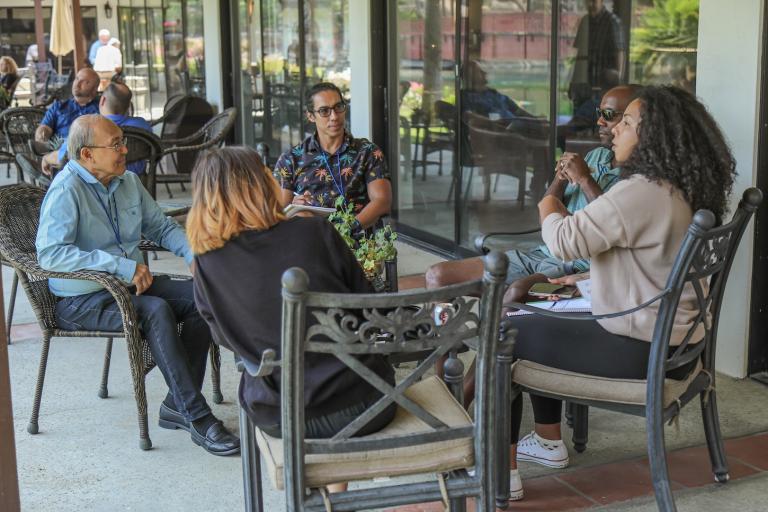
In order to create beautiful and vulnerable small group space, a healthy container first has to be co-constructed.
This container might be created by and filled with life-long friends, trusted family members, or complete strangers. It might have a formal leader or be more egalitarian with shared facilitation. It might have rigid structures or flexible guidelines.
But in order for folks to settle in, for their nervous systems to regulate, for their fight/flight/freeze mechanism to calm, there needs to be a container – a structure – that can hold and embolden their vulnerability and desire for deep connection (with themselves, with others, and with the Divine.)
Here’s a small group structure I’ve loved using and refining over the past few years.
Creating the Container
For each gathering, it’s important to “create a container” for the group. A container sets the tone, establishes a rhythm for what to expect, and holds the experience. A good container will invite bravery and vulnerability, while reducing fear, shame, and guilt.
Physical Space:
If possible, meet in the homes of people in the group or in public spaces like coffeeshops. If your group is affiliated with a faith community, try switching it up and refraining from meeting in your faith community’s building.
Ritual Space:
If possible, gather together in a circle so that everyone can see everyone. You might sit on couches or chairs or the floor. If it feels right, you can create a small table of intention in the center or off to the side where you place a few objects important to individuals in the group. Each gathering, trade off facilitating (or share duties) so that everyone feels empowered and responsible for the group.
Opening
As you gather, invite each other to close their eyes and pay attention to their breath. (Let it be silent for 30 seconds.) Then, invite each person to bring to mind the emotion they are feeling most present with them right now. Invite people, as they are ready, to say their name, the emotion they are carrying, and “I am here.”
Example: “My name is Andrew. I’m feeling a bit anxious. And I am here.”
Afterwards, name a set of communal intentions for the group. Below are the ones I use. Feel free to ask the group to name their own intentions into the space if that feels more authentic.
- Speak from the Heart (say what is on your heart, not just in your head)
- Listen from the Heart (practice being curious – no advising, correcting, or fixing)
- Say Just Enough (not necessarily short, but avoid the non-essentials)
- Spontaneous (not rehearsing what we’re going to say while others are sharing)
Body Practice
As a group, take some time to engage your body.
This might be through:
- a body scan,
- a breath practice,
- a walking meditation,
- centering prayer,
- or something else entirely!
The purpose of this time is to help to ground us in the present moment and help our nervous systems to settle. Make sure not to rush this – take your time!
(If you’re interested in Centering Prayer, there’s an amazing virtual summit coming up headlining Cynthia Bourgeault, Carl McColman, Phileena Nikole, and Adam Bucko! Check it out here!)
Sharing
Before introducing any prompts, remind folks to let people share uninterrupted – this might be difficult, but we want to let stories emerge from the person however they’re going to. This creates space for sharing and listening without the expectation of engagement.
After sharing, you might allow for responses and conversation or not; ask the group what they want! (And this might differ person to person. You might create a ritual of saying “open for ______” (questions, comments, ideas, etc.) or “not open for follow-up” after sharing if a person wants or doesn’t want engagement.)
Whoever is facilitating should make sure they have at least two or three prompts ready. Make sure the prompts are broad or vague enough to have multiple entry points. They should be centered on storytelling and heart-space; ask questions that open people up to sharing stories.
Examples:
- “Tell a story of when you experienced disillusionment or saw something in a new way”.
- “What crossroads in your life do you find yourself at right now?”
- “What does this constriction feel like in your body or how does it impact you?”
- “How are you experiencing expansion in your life right now?”
It’s a good idea to always remind the group they can share whatever is most pressing and present to them in the moment, regardless of prompt. Silence is also always acceptable. The group may touch one or two prompts, or may veer off and follow where the group needs to go.
“Reading the room’, rather than imposing pre-determined topics, is best.
Witness
Before ending the gathering, spend some time wrapping up and closing the container.
You can do this by having a “witness round” where each person is invited to share a short word or phrase or theme they heard/experienced during the group’s time together. This is a way to sum up and contain (without fully containing) the experience. Similar to the opening check-in, this should be fairly quick.
Example: “Let’s go ahead and do a quick Witness Round. This is where we can each name a theme or word or phrase that has popped out to us during our time together. Let’s go clockwise, whoever wants to start can start.”
Closing
As with most things in this structure, there is no prescribed way of closing out the gathering.
The point is to link together in some form of solidarity. If you’re in-person, you might choose to hold hands and take a few breaths together before ending with a poem/prayer/question. If you’re having a virtual group, perhaps give folks a few moments just to look at the other faces in the group, seeking connection with them. Read the room and do whatever feels appropriate in the moment as a way of connecting and ending.
You can always ask for help from the group if you get stuck! (And model some vulnerability!)
Hope this helps! If you’d like a printable version of this framework, you can check it out here.













